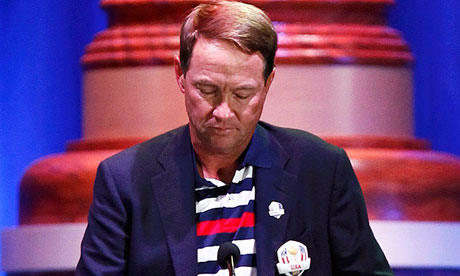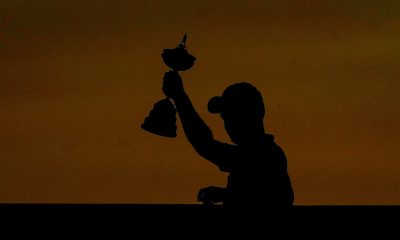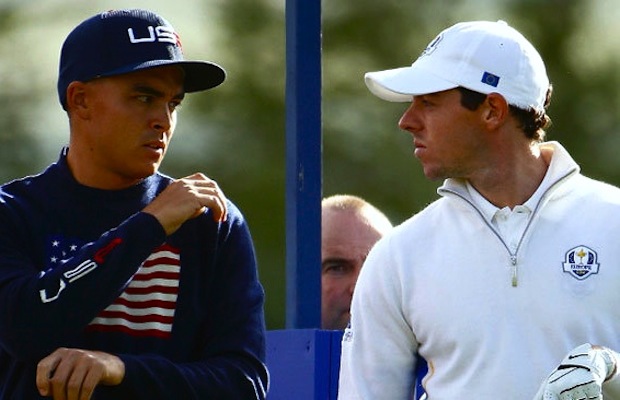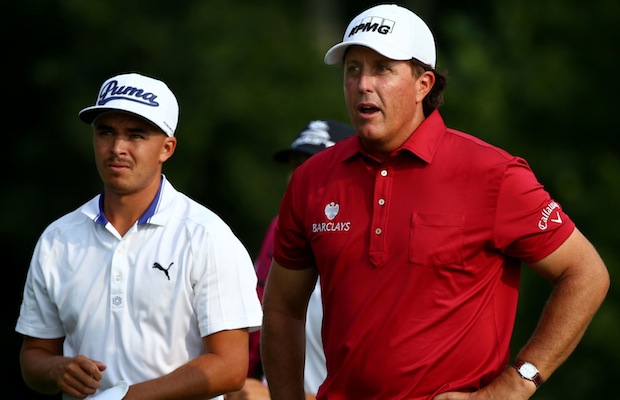Opinion & Analysis
Post Mortem: Fixing the U.S. Ryder Cup Team

By Seth Kerr
GolfWRX Staff Writer
Every golfer, writer, and Monday morning quarterback has given his or her opinions on what went wrong with the 2012 Unitied States Team. Many believe the U.S. Team didn’t want to win as bad as the Europeans, pointing to Bubba Watson’s congratulatory tweets and Phil Mickelson’s thumbs-up while losing to Justin Rose as two examples.
The problem is, no one has said how to fix it. The U.S. has only won once this century and a meager one time on foreign soil since 1993. For a majority of those years, Tiger and Phil were playing and still couldn’t win on European soil.
But instead of crying about the past, its time to provide the PGA of America with a plan to win moving forward.
Paul Azinger
In 2005, USA Basketball hired Jerry Colangelo to take responsibility for picking the team after disappointing finishes in 2002 and 2004. His teams went on to win the Olympics in 2008 and 2012 with a little help from Mike Krzyzewski.
Well the PGA of America needs their Jerry Colangelo.
I don’t know who is in charge of picking the captain, other than it’s the PGA of America, but shouldn’t I? I watch much more golf than basketball and have no idea who runs the show. Wouldn’t the Ryder Cup benefit from having a well-known player in charge of the team?
It’s an easy choice really: Paul Azinger
He is the last captain to win, one of the most intense players in U.S. Ryder Cup history and shows more passion announcing the Ryder Cup than most of the players playing. He put together a system that worked when nothing before it, or since it, has. The team needs the fire and intensity he shows, and he would put everything into the job.
The job is too difficult for a once every two year (more on this later) captain who is normally still trying to play on Tour. The captain needs to be Coach K. Don’t worry about all the administerial tasks leading up to the Cup. Come in and lead the team to victory when the Cup starts.
Azinger is the perfect person to have in charge of the U.S. Team. He can work to implement and assist the captain in formulating a plan and picking a team for victory. In the two years between Ryder Cups, he can scout players on a weekly basis, since he rarely plays and is normally announcing each week. He can arrange team outfits, dinners, practice schedules and everything leading up to the Ryder Cup that is a drain on the captain. Then during the week of the Cup he can be there to assist the captain and provide another pair of eyes on the course.
Choosing a Captain and Assistant Captains
Azinger’s most important job will be to pick a captain. And to pick a captain who plans to captain for four years. Yes, four years. No more two-year captains. There are not enough decent players to have a new captain every two years.
Look at the names the U.S. Team has to pick from moving ahead. There aren’t many players. The early name being banded about for 2014 is David Toms. No disrespect to Mr. Toms but he is still actively playing, and playing worse than all 12 members of the team.
The Captain should be someone who has done something special in golf, not just the next American in line. Staying for four years will give the team consistency and make sure the field of potential captains to choose from isn’t too thin.
The same is true of Assistant Captains. Assistant Captains only qualification should not be being friends with the Captain. Fred Couples and now Davis Love III took flak for having Michael Jordan as an assistant. You tell me who is likely to bring more awe and inspiration to the team, Mike Hulbert and Scott Verplank or Michael Jordan?
Picking a Team
The U.S. players seem to be at a disadvantage when it comes to the “team” aspect of the competition. Maybe its because they gravitate toward each other on the PGA Tour, but for whatever reason the Europeans seem closer. he U.S. Team has to do something to close the gap.
Getting the players together more often is the way to do it. Every two years the Cup is played somewhere in Europe. What is stopping the captain from getting a group of players together for a couple days each year before or after the British Open to get together, play the course, have dinner together, and hang out to get to know each other. The majority of top Americans are in Europe anyway so it should be pretty simple to schedule.
The years the Cup is in the U.S. it would be even easier to get a group of guys together.
Invite the top 25 Americans in the world and see how they bond and like the course. See who likes to play together, and who is a fit on the course or which young guys hold up to the pressure of playing with the veterans.
Your telling me the players not guaranteed a spot wouldn’t show up to make sure the Captain knows they want to make the team?
Plan for the future
This one should seem pretty obvious. The team should always be planning for the future, but do they?
Looking at the 2012 Team, how many players would you guarantee will be on the 2014 team or 2016 team?
Probably Tiger, but are we sure he can get his game back to the top and play under pressure? He hasn’t shown the ability to perform under real pressure with his new swing. Plus he has an old body with a number of ailments. It is a fair question if his body will hold up two or four more years.
Phil? It’s conceivable Phil won’t be in the top eight of the point standings in two years. He already plays a limited schedule and will continue to do so as he ages and his family time becomes more and more valuable. Not to mention, he didn’t exactly set the Tour on fire this year anyway.
You can assume Bubba, Webb Simpson, Keegan Bradley, Jason Dufner and Dustin Johnson have a chance to play in many more Ryder Cups. All five played reasonably well this year and Dufner and Johnson even won their Sunday matches.
The rest? We have probably seen the last of Jim Furyk and Steve Stricker. Zach Johnson and Matt Kuchar could make the team again, but their spots are hardly guaranteed.
It’s time to build a farm system for the U.S. Team.
This year’s team should have brought a number of younger players to Medinah to soak in the experience and see what they could expect from playing in the Ryder Cup. Having Nick Watney, Kyle Stanley, Bill Haas and other guys come to Medinah and learn from the experience would have been invaluable, so if they make the team someday they would know what to expect.
In 2014, a group of young guns should make the trip to Gleneagles. Call them team interns if you want.
Doing the same thing the last 20 years and expecting to stem the European tide has done nothing to help the PGA of America. Chalking up 2012 to a herculean comeback would be a foolish mistake. The question is whether anybody is going to do something about it.
Opinion & Analysis
The 2 primary challenges golf equipment companies face

As the editor-in-chief of this website and an observer of the GolfWRX forums and other online golf equipment discourse for over a decade, I’m pretty well attuned to the grunts and grumbles of a significant portion of the golf equipment purchasing spectrum. And before you accuse me of lording above all in some digital ivory tower, I’d like to offer that I worked at golf courses (public and private) for years prior to picking up my pen, so I’m well-versed in the non-degenerate golf equipment consumers out there. I touched (green)grass (retail)!
Complaints about the ills of and related to the OEMs usually follow some version of: Product cycles are too short for real innovation, tour equipment isn’t the same as retail (which is largely not true, by the way), too much is invested in marketing and not enough in R&D, top staffer X hasn’t even put the new driver in play, so it’s obviously not superior to the previous generation, prices are too high, and on and on.
Without digging into the merits of any of these claims, which I believe are mostly red herrings, I’d like to bring into view of our rangefinder what I believe to be the two primary difficulties golf equipment companies face.
One: As Terry Koehler, back when he was the CEO of Ben Hogan, told me at the time of the Ft Worth irons launch, if you can’t regularly hit the golf ball in a coin-sized area in the middle of the face, there’s not a ton that iron technology can do for you. Now, this is less true now with respect to irons than when he said it, and is less and less true by degrees as the clubs get larger (utilities, fairways, hybrids, drivers), but there remains a great deal of golf equipment truth in that statement. Think about it — which is to say, in TL;DR fashion, get lessons from a qualified instructor who will teach you about the fundamentals of repeatable impact and how the golf swing works, not just offer band-aid fixes. If you can’t repeatably deliver the golf club to the golf ball in something resembling the manner it was designed for, how can you expect to be getting the most out of the club — put another way, the maximum value from your investment?
Similarly, game improvement equipment can only improve your game if you game it. In other words, get fit for the clubs you ought to be playing rather than filling the bag with the ones you wish you could hit or used to be able to hit. Of course, don’t do this if you don’t care about performance and just want to hit a forged blade while playing off an 18 handicap. That’s absolutely fine. There were plenty of members in clubs back in the day playing Hogan Apex or Mizuno MP-32 irons who had no business doing so from a ballstriking standpoint, but they enjoyed their look, feel, and complementary qualities to their Gatsby hats and cashmere sweaters. Do what brings you a measure of joy in this maddening game.
Now, the second issue. This is not a plea for non-conforming equipment; rather, it is a statement of fact. USGA/R&A limits on every facet of golf equipment are detrimental to golf equipment manufacturers. Sure, you know this, but do you think about it as it applies to almost every element of equipment? A 500cc driver would be inherently more forgiving than a 460cc, as one with a COR measurement in excess of 0.83. 50-inch shafts. Box grooves. And on and on.
Would fewer regulations be objectively bad for the game? Would this erode its soul? Fortunately, that’s beside the point of this exercise, which is merely to point out the facts. The fact, in this case, is that equipment restrictions and regulations are the slaughterbench of an abundance of innovation in the golf equipment space. Is this for the best? Well, now I’ve asked the question twice and might as well give a partial response, I guess my answer to that would be, “It depends on what type of golf you’re playing and who you’re playing it with.”
For my part, I don’t mind embarrassing myself with vintage blades and persimmons chasing after the quasi-spiritual elevation of a well-struck shot, but that’s just me. Plenty of folks don’t give a damn if their grooves are conforming. Plenty of folks think the folks in Liberty Corner ought to add a prison to the museum for such offences. And those are just a few of the considerations for the amateur game — which doesn’t get inside the gallery ropes of the pro game…
Different strokes in the game of golf, in my humble opinion.
Anyway, I believe equipment company engineers are genuinely trying to build better equipment year over year. The marketing departments are trying to find ways to make this equipment appeal to the broadest segment of the golf market possible. All of this against (1) the backdrop of — at least for now — firm product cycles. And golfers who, with their ~15 average handicap (men), for the most part, are not striping the golf ball like Tiger in his prime and seem to have less and less time year over year to practice and improve. (2) Regulations that massively restrict what they’re able to do…
That’s the landscape as I see it and the real headwinds for golf equipment companies. No doubt, there’s more I haven’t considered, but I think the previous is a better — and better faith — point of departure when formulating any serious commentary on the golf equipment world than some of the more cynical and conspiratorial takes I hear.
Agree? Disagree? Think I’m worthy of an Adam Hadwin-esque security guard tackle? Let me know in the comments.
@golfoncbs The infamous Adam Hadwin tackle ? #golf #fyp #canada #pgatour #adamhadwin ? Ghibli-style nostalgic waltz – MaSssuguMusic
Podcasts
Fore Love of Golf: Introducing a new club concept

Episode #16 brings us Cliff McKinney. Cliff is the founder of Old Charlie Golf Club, a new club, and concept, to be built in the Florida panhandle. The model is quite interesting and aims to make great, private golf more affordable. We hope you enjoy the show!
Opinion & Analysis
On Scottie Scheffler wondering ‘What’s the point of winning?’

Last week, I came across a reel from BBC Sport on Instagram featuring Scottie Scheffler speaking to the media ahead of The Open at Royal Portrush. In it, he shared that he often wonders what the point is of wanting to win tournaments so badly — especially when he knows, deep down, that it doesn’t lead to a truly fulfilling life.
View this post on Instagram
“Is it great to be able to win tournaments and to accomplish the things I have in the game of golf? Yeah, it brings tears to my eyes just to think about it because I’ve literally worked my entire life to be good at this sport,” Scheffler said. “To have that kind of sense of accomplishment, I think, is a pretty cool feeling. To get to live out your dreams is very special, but at the end of the day, I’m not out here to inspire the next generation of golfers. I’m not out here to inspire someone to be the best player in the world, because what’s the point?”
Ironically — or perhaps perfectly — he went on to win the claret jug.
That question — what’s the point of winning? — cuts straight to the heart of the human journey.
As someone who’s spent over two decades in the trenches of professional golf, and in deep study of the mental, emotional, and spiritual dimensions of the game, I see Scottie’s inner conflict as a sign of soul evolution in motion.
I came to golf late. I wasn’t a junior standout or college All-American. At 27, I left a steady corporate job to see if I could be on the PGA Tour starting as a 14-handicap, average-length hitter. Over the years, my journey has been defined less by trophies and more by the relentless effort to navigate the deeply inequitable and gated system of professional golf — an effort that ultimately turned inward and helped me evolve as both a golfer and a person.
One perspective that helped me make sense of this inner dissonance around competition and our culture’s tendency to overvalue winning is the idea of soul evolution.
The University of Virginia’s Division of Perceptual Studies has done extensive research on reincarnation, and Netflix’s Surviving Death (Episode 6) explores the topic, too. Whether you take it literally or metaphorically, the idea that we’re on a long arc of growth — from beginner to sage elder — offers a profound perspective.
If you accept the premise literally, then terms like “young soul” and “old soul” start to hold meaning. However, even if we set the word “soul” aside, it’s easy to see that different levels of life experience produce different worldviews.
Newer souls — or people in earlier stages of their development — may be curious and kind but still lack discernment or depth. There is a naivety, and they don’t yet question as deeply, tending to see things in black and white, partly because certainty feels safer than confronting the unknown.
As we gain more experience, we begin to experiment. We test limits. We chase extreme external goals — sometimes at the expense of health, relationships, or inner peace — still operating from hunger, ambition, and the fragility of the ego.
It’s a necessary stage, but often a turbulent and unfulfilling one.
David Duval fell off the map after reaching World No. 1. Bubba Watson had his own “Is this it?” moment with his caddie, Ted Scott, after winning the Masters.
In Aaron Rodgers: Enigma, reflecting on his 2011 Super Bowl win, Rodgers said:
“Now I’ve accomplished the only thing that I really, really wanted to do in my life. Now what? I was like, ‘Did I aim at the wrong thing? Did I spend too much time thinking about stuff that ultimately doesn’t give you true happiness?’”
Jim Carrey once said, “I think everybody should get rich and famous and do everything they ever dreamed of so they can see that it’s not the answer.”
Eventually, though, something shifts.
We begin to see in shades of gray. Winning, dominating, accumulating—these pursuits lose their shine. The rewards feel more fleeting. Living in a constant state of fight-or-flight makes us feel alive, yes, but not happy and joyful.
Compassion begins to replace ambition. Love, presence, and gratitude become more fulfilling than status, profits, or trophies. We crave balance over burnout. Collaboration over competition. Meaning over metrics.
Interestingly, if we zoom out, we can apply this same model to nations and cultures. Countries, like people, have a collective “soul stage” made up of the individuals within them.
Take the United States, for example. I’d place it as a mid-level soul: highly competitive and deeply driven, but still learning emotional maturity. Still uncomfortable with nuance. Still believing that more is always better. Despite its global wins, the U.S. currently ranks just 23rd in happiness (as of 2025). You might liken it to a gifted teenager—bold, eager, and ambitious, but angsty and still figuring out how to live well and in balance. As much as a parent wants to protect their child, sometimes the child has to make their own mistakes to truly grow.
So when Scottie Scheffler wonders what the point of winning is, I don’t see someone losing strength.
I see someone evolving.
He’s beginning to look beyond the leaderboard. Beyond metrics of success that carry a lower vibration. And yet, in a poetic twist, Scheffler did go on to win The Open. But that only reinforces the point: even at the pinnacle, the question remains. And if more of us in the golf and sports world — and in U.S. culture at large — started asking similar questions, we might discover that the more meaningful trophy isn’t about accumulating or beating others at all costs.
It’s about awakening and evolving to something more than winning could ever promise.




















